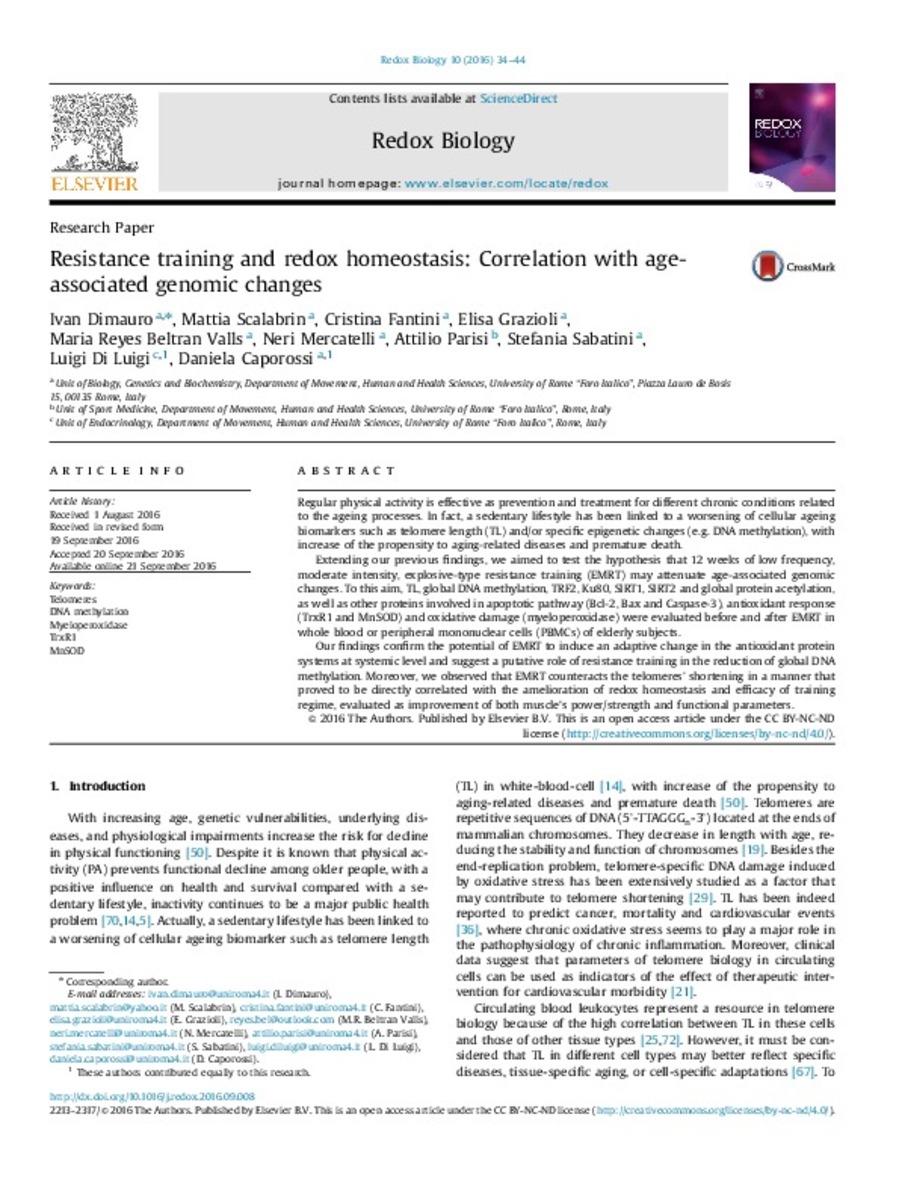Mostrar el registro sencillo del ítem
Resistance training and redox homeostasis: Correlation with age-associated genomic changes
| dc.contributor.author | Dimauro, Ivan | |
| dc.contributor.author | Scalabrin, Mattia | |
| dc.contributor.author | Fantini, Cristina | |
| dc.contributor.author | Graziolo, Elisa | |
| dc.contributor.author | Beltran Valls, Maria Reyes | |
| dc.contributor.author | Mercatelli, Neri | |
| dc.contributor.author | Parisi, Attilio | |
| dc.contributor.author | Sabatini, Stefania | |
| dc.contributor.author | Di Luigi, Luigi | |
| dc.date.accessioned | 2017-04-28T18:17:59Z | |
| dc.date.available | 2017-04-28T18:17:59Z | |
| dc.date.issued | 2016 | |
| dc.identifier.citation | DIMAURO, Ivan, et al. Resistance training and redox homeostasis: Correlation with age-associated genomic changes. Redox biology, 2016, vol. 10, p. 34-44 | ca_CA |
| dc.identifier.issn | 2213-2317 | |
| dc.identifier.uri | http://hdl.handle.net/10234/167318 | |
| dc.description.abstract | Regular physical activity is effective as prevention and treatment for different chronic conditions related to the ageing processes. In fact, a sedentary lifestyle has been linked to a worsening of cellular ageing biomarkers such as telomere length (TL) and/or specific epigenetic changes (e.g. DNA methylation), with increase of the propensity to aging-related diseases and premature death. Extending our previous findings, we aimed to test the hypothesis that 12 weeks of low frequency, moderate intensity, explosive-type resistance training (EMRT) may attenuate age-associated genomic changes. To this aim, TL, global DNA methylation, TRF2, Ku80, SIRT1, SIRT2 and global protein acetylation, as well as other proteins involved in apoptotic pathway (Bcl-2, Bax and Caspase-3), antioxidant response (TrxR1 and MnSOD) and oxidative damage (myeloperoxidase) were evaluated before and after EMRT in whole blood or peripheral mononuclear cells (PBMCs) of elderly subjects. Our findings confirm the potential of EMRT to induce an adaptive change in the antioxidant protein systems at systemic level and suggest a putative role of resistance training in the reduction of global DNA methylation. Moreover, we observed that EMRT counteracts the telomeres’ shortening in a manner that proved to be directly correlated with the amelioration of redox homeostasis and efficacy of training regime, evaluated as improvement of both muscle's power/strength and functional parameters. | ca_CA |
| dc.description.sponsorShip | This work was supported by grants from MIUR (PRIN2012) to DC and from University of Rome “Foro Italico” (Research Grant 2013) to LDL. Further, we thank the “Veronesi Foundation” for the fellowships given to Dr. Ivan Dimauro | ca_CA |
| dc.format.extent | 11 p. | ca_CA |
| dc.format.mimetype | application/pdf | ca_CA |
| dc.language.iso | eng | ca_CA |
| dc.publisher | Elsevier | ca_CA |
| dc.relation.isPartOf | Redox biology, 2016, vol. 10 | ca_CA |
| dc.rights | © 2016 The Authors. Published by Elsevier B.V. This is an open access article under the CCBY-NC-ND license (http://creativecommons.org/licenses/by-nc-nd/4.0/) | ca_CA |
| dc.rights | Atribución-NoComercial-CompartirIgual 4.0 España | * |
| dc.rights.uri | http://creativecommons.org/licenses/by-nc-nd/4.0/ | * |
| dc.subject | Telomeres | ca_CA |
| dc.subject | DNA methylation | ca_CA |
| dc.subject | Myeloperoxidase | ca_CA |
| dc.subject | TrxR1 | ca_CA |
| dc.subject | MnSOD | ca_CA |
| dc.title | Resistance training and redox homeostasis: Correlation with age-associated genomic changes | ca_CA |
| dc.type | info:eu-repo/semantics/article | ca_CA |
| dc.rights.accessRights | info:eu-repo/semantics/openAccess | ca_CA |
| dc.relation.publisherVersion | http://www.sciencedirect.com/science/article/pii/S2213231716300957 | ca_CA |
Ficheros en el ítem
Este ítem aparece en la(s) siguiente(s) colección(ones)
-
EDU_Articles [501]








